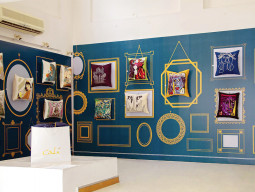
From a full-fledged market on Kumhar Road, the pottery shops have scald down to just four. Despite being used by all income groups alike, the skill behind the pots was forced out of the city owing to environmental concerns.

Currently, shopkeepers import clay-made utensils from Gujrat, Gujranwala and Lala Musa. PHOTOS: MUHAMMAD JAVAID/EXPRESS
“The educated people and high-ranked officers would force the kiln owners to close or shift their businesses to rural areas. They would complain that the smoke from the kilns was polluting the clean environment,” said Mehmood Butt, a shop owner.
Kiln owners reluctantly shifted their kilns to rural areas but the art died with the passage of time. Currently, shopkeepers import clay-made utensils from Gujrat, Gujranwala and Lala Musa and other areas from central and South Punjab.
Pots are made from a special clay dug three feet below the earth, reveals Butt.
The clay is then molded, dried and glazed for finesse. “The clay is a natural product dug from several feet below the ground,” he said.
Butt added that the clay-utensils are made from a mixture of clay that is different from raw clay. Additives are mixed with it, worked and a glass coating is applied to the utensils,” said the shopkeeper.
The earthenware pots, however, with passage of time, became extinct and were soon replaced by aluminum and steel utensils.
There was a time when even folk poets romanticised clay pots in their poetry. The art is very old, and has undergone many mutations but the clay and glazed pottery has still survived owing to its artistic uniqueness.
To cater to the thinning market, the potters are applying modern techniques to their skills. Cooking vessels, tea pots, glasses, jugs, flower clay pots, lamps and toys are decorated beautifully to attract customers with a traditional buying tinge.

Currently, shopkeepers import clay-made utensils from Gujrat, Gujranwala and Lala Musa. PHOTOS: MUHAMMAD JAVAID/EXPRESS
Customers, mostly from the higher income group, buy the wares as decoration pieces.
Butt insists that food cooked in the earthenware dishes have no side-affects and tastes better. “Food cooked in clay pots is not only tasty and sweet but also healthy. The food has its own sweetness and is rich in flavour,” he added. Clay pots are also used as coolants to keep the water cool and fresh during summers. The decorated pots also attract schools tudents who buy pots for painting.

Though Butt has inherited this art from his forefathers, he reminiscences the time when people treasured pottery.
Published in The Express Tribune, December 1st, 2014.




































1713853507-0/MalalaHilary-(2)1713853507-0-270x192.webp)







COMMENTS
Comments are moderated and generally will be posted if they are on-topic and not abusive.
For more information, please see our Comments FAQ